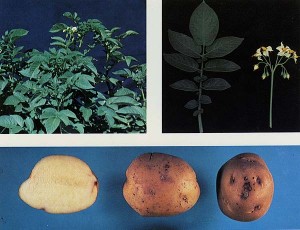Kennebec (Solanum tuberosum)
ORIGIN: Released by the USDA and the Maine Agricultural Experiment Station in 1948. The variety was selected from a cross between B127 and USDA 96-56 and was tested as B70-5. Published in American Potato Journal 25:351-361, 1948.
CHARACTERISTICS: Kennebec is widely adapted and is grown in many parts of the world. At one time it was the primary variety used for potato chip processing in the U.S. and Canada. It was also important in french fry processing. On the table stock market its reputation for good culinary quality was well known. The variety produces a high yield of large tubers.
Plants are main season in maturity. They are large, developing a dense canopy shortly after emergence. The plant is generally light green in color with no purple pigmentation. Leaflets are long and narrow. Flowers are white and often abort before opening. Tubers are oblong, slightly flattened with shallow eyes. Tubers of this variety are characterized by a thin, smooth white skin. Under some conditions tubers are misshapen. Tuber conformation is best in cool growing conditions. Specific gravity is medium high and cooking quality is good. Dormancy is medium.
Kennebec represent determinate varieties (generally “early” varieties), producing one crop that is mature enough for harvest at roughly the same time.
STRENGTHS & WEAKNESSES: The consistently high yield and good culinary qualities are the primary strengths of this variety. It has specific gene (R1) and moderate field resistance to late blight and is resistant to net necrosis. It is very susceptible to Verticillium wilt and pinkeye and requires long rotations. Storing for chipstock has been a problem because of the pinkeye susceptibility, tendency to bruise, and the need to store at temperatures of 50oF (10 degrees C) or more for good chip color. Its popularity as a chipping variety has decreased as better storing, more consistent chipping varieties have been developed. Its susceptibility to Verticillium wilt and tuber greening and its tendency to produce misshapen tubers are major limitations for tablestock producers.
